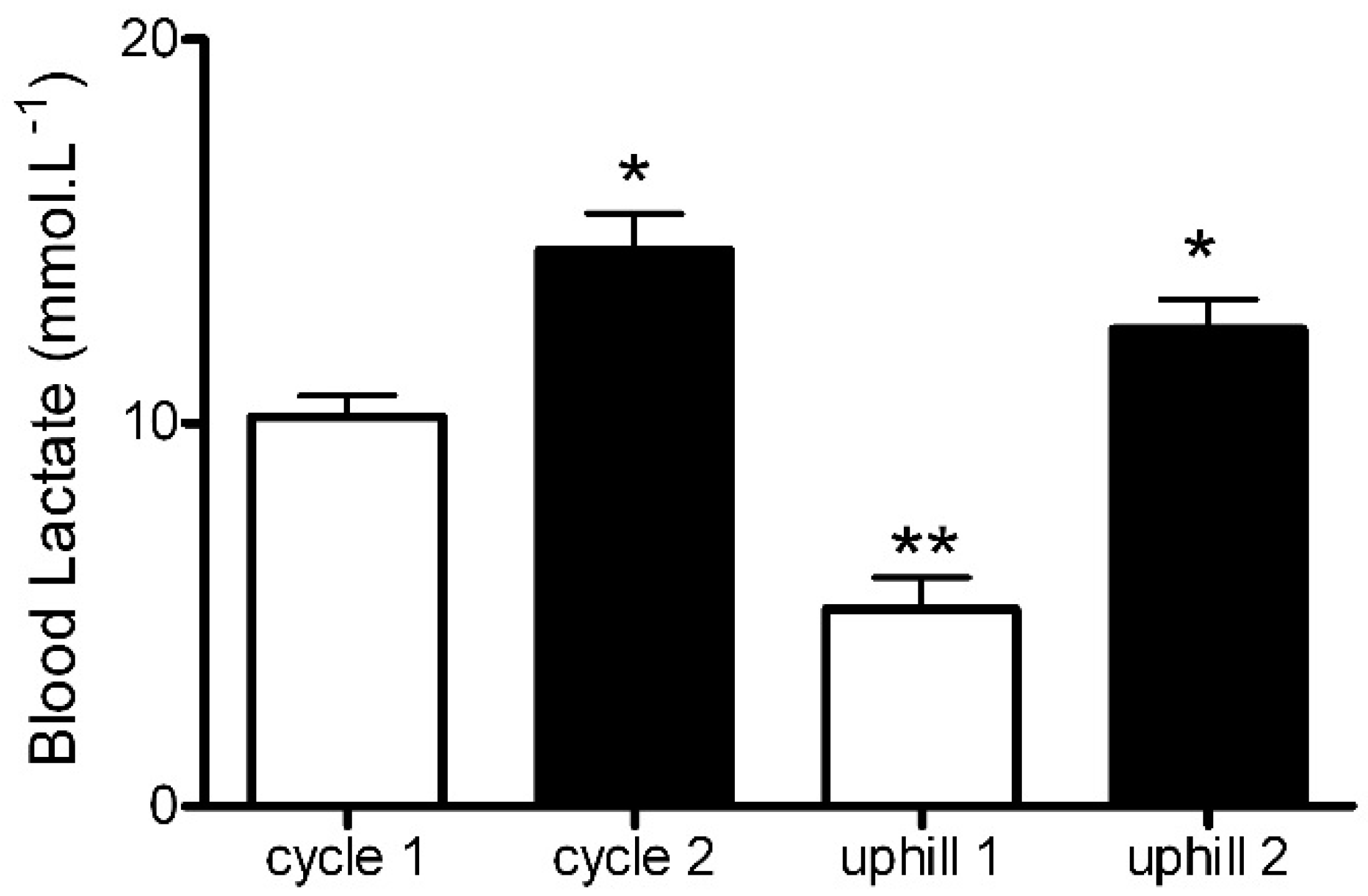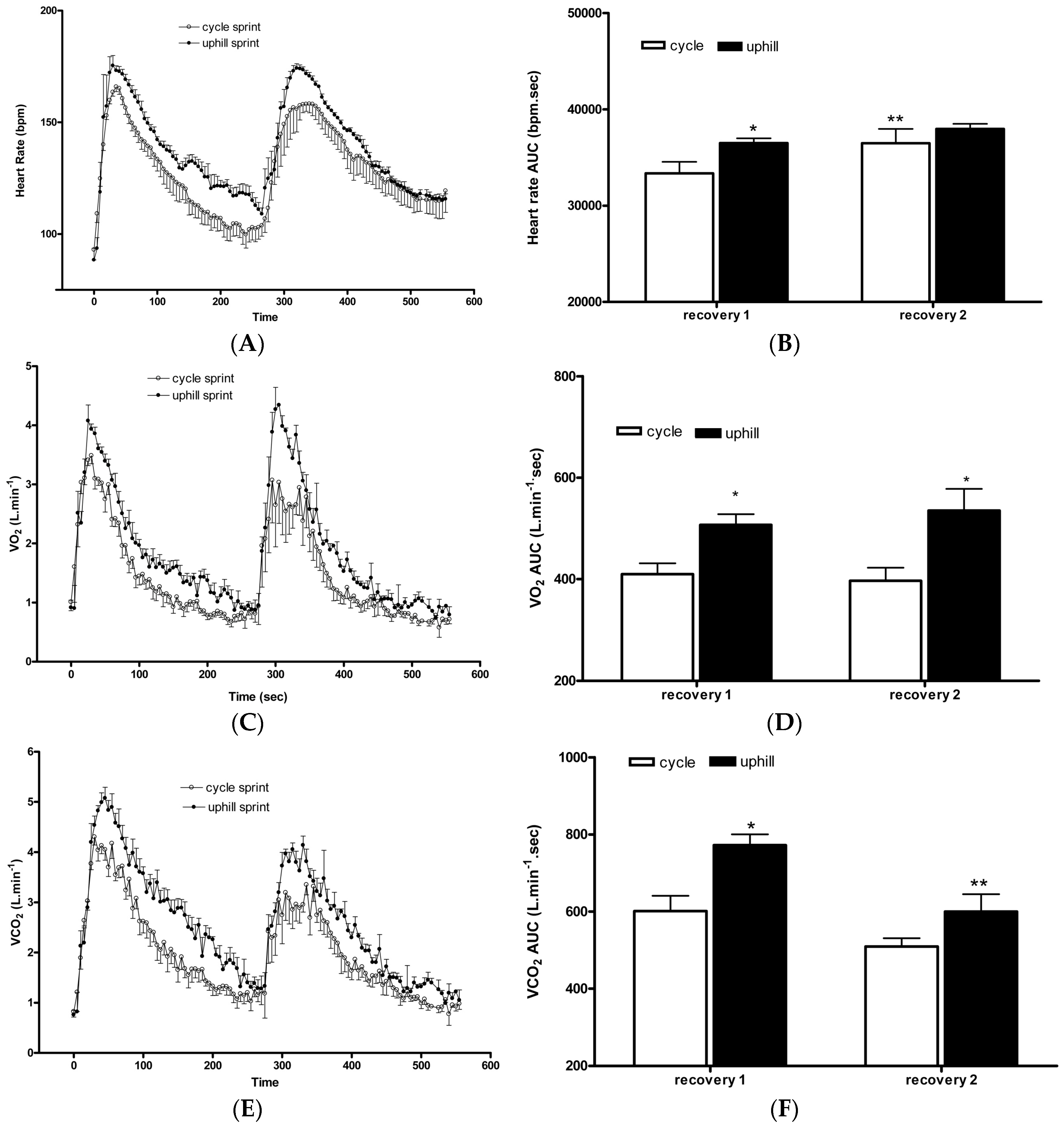Early Adaptations to a Two-Week Uphill Run Sprint Interval Training and Cycle Sprint Interval Training
Abstract
1. Introduction
2. Materials and Methods
2.1. Participants
2.2. Procedures
2.2.1. Baseline Testing
2.2.2. Run VO2Peak
2.2.3. Cycle VO2Peak
2.2.4. Sprint Interval Training Protocol
2.2.5. Uphill Sprint Training Protocol
2.2.6. Acute Responses to both Training Protocols
2.2.7. Lactate Measurement
2.3. Statistical Analysis
3. Results
3.1. Training Results
3.1.1. VO2Peak
3.1.2. Time-to-Exhaustion
3.1.3. Ventilatory Threshold
3.1.4. Average Power
3.2. Acute Responses of Training
3.2.1. Blood Lactate
3.2.2. Heart Rate, VO2, and VCO2
4. Discussion
4.1. Training Adaptations
4.1.1. VO2Peak
4.1.2. TTE
4.1.3. VT
4.2. Acute Responses
5. Study Limitations
6. Conclusions
Author Contributions
Funding
Acknowledgments
Conflicts of Interest
References
- Gillen, J.B.; Martin, B.J.; MacInnis, M.J.; Skelly, L.E.; Tarnopolsky, M.A.; Gibala, M.J. Twelve weeks of sprint interval training improves indices of cardiometabolic health similar to traditional endurance training despite a five-fold lower exercise volume and time commitment. PLoS ONE 2016, 11, e0154075. [Google Scholar] [CrossRef] [PubMed]
- Gibala, M.J.; Gillen, J.B.; Percival, M.E. Physiological and health-related adaptations to low-volume interval training: Influences of nutrition and sex. Sport. Med. 2014, 44, 127–137. [Google Scholar] [CrossRef] [PubMed]
- Burgomaster, K.A.; Hughes, S.C.; Heigenhauser, G.J.F.; Bradwell, S.N.; Gibala, M.J. Six sessions of sprint interval training increases muscle oxidative potential and cycle endurance capacity in humans. J. Appl. Physiol. 2005, 98, 1985–1990. [Google Scholar] [CrossRef] [PubMed]
- Green, J.; Smith, J.; MacDougall, D.K.M.; Hicks, A.L.; MacDonald, J.R.; McKelvie, R.S.; MacDougall, D.J.; MacDonald, J.R.; Mckelvie, R.S.; Green, H.J.; et al. Muscle performance and enzymatic adaptations to sprint interval training. J. Appl. Physiol. 1998, 84, 2138–2142. [Google Scholar]
- Hazell, T.J.; MacPherson, R.E.K.; Gravelle, B.M.R.; Lemon, P.W.R. 10 or 30-s Sprint interval training bouts enhance both aerobic and anaerobic performance. Eur. J. Appl. Physiol. 2010, 110, 153–160. [Google Scholar] [CrossRef] [PubMed]
- Gist, N.H.; Fedewa, M.V.; Dishman, R.K.; Cureton, K.J. Sprint interval training effects on aerobic capacity: A systematic review and meta-analysis. Sports Med. 2014, 44, 269–279. [Google Scholar] [CrossRef] [PubMed]
- Sandvei, M.; Jeppesen, P.B.; Støen, L.; Litleskare, S.; Johansen, E.; Stensrud, T.; Enoksen, E.; Hautala, A.; Martinmäki, K.; Kinnunen, H.; et al. Sprint interval running increases insulin sensitivity in young healthy subjects. Arch. Physiol. Biochem. 2012, 118, 139–147. [Google Scholar] [CrossRef] [PubMed]
- Willoughby, T.N.; Thomas, M.P.L.; Schmale, M.S.; Copeland, J.L.; Hazell, T.J. Four weeks of running sprint interval training improves cardiorespiratory fitness in young and middle-aged adults. J. Sports Sci. 2016, 34, 1207–1214. [Google Scholar] [CrossRef] [PubMed]
- Kavaliauskas, M.; Kilvington, R.; Babraj, J. Effects of In-season uphill sprinting on physical characteristics in semi-professional soccer players. J. Sports Med. Phys. Fit. 2015, 57, 165–170. [Google Scholar]
- Jakeman, J.R.; McMullan, J.; Babraj, J.A. Efficacy of a four-week uphill sprint training intervention in field hockey players. J. Strength Cond. Res. 2016, 30, 2761–2766. [Google Scholar] [CrossRef] [PubMed]
- Ferley, D.D.; Osborn, R.W.; Vukovich, M.D. The Effects of uphill vs. level-grade high-intensity interval training on VO2max, Vmax, VLT, and Tmax in well-trained distance runners. J. Strength Cond. Res. 2013, 27, 1549–1559. [Google Scholar] [CrossRef] [PubMed]
- Weston, M.; Taylor, K.L.; Batterham, A.M.; Hopkins, W.G. Effects of low-volume high-intensity interval training (HIT) on fitness in adults: A meta-analysis of controlled and non-controlled trials. Sports Med. 2014, 44, 1005–1017. [Google Scholar] [CrossRef] [PubMed]
- Vollaard, N.B.J.; Metcalfe, R.S.; Williams, S. Effect of number of sprints in an SIT session on change in VO2max. Med. Sci. Sports Exerc. 2017, 49, 1147–1156. [Google Scholar] [CrossRef] [PubMed]
- Harling, S.A.; Tong, R.J.; Mickleborough, T.D. The Oxygen uptake response running to exhaustion at peak treadmill speed. Med. Sci. Sports. Exerc. 2003, 35, 663–668. [Google Scholar] [CrossRef] [PubMed]
- Gaskill, S.E.; Ruby, B.C.; Walker, A.J.; Sanchez, O.A.; Serfass, R.C.; Leon, A.S. Validity and reliability of combining three methods to determine ventilatory threshold. Med. Sci. Sports Exerc. 2001, 33, 1841–1848. [Google Scholar] [CrossRef] [PubMed]
- Burgomaster, K.A.; Cermak, N.M.; Phillips, S.M.; Benton, C.R.; Bonen, A.; Gibala, M.J. Divergent response of metabolite transport proteins in human skeletal muscle after sprint interval training and detraining. Am. J. Physiol. Integr. Comp. Physiol. 2007, 292, R1970–R1976. [Google Scholar] [CrossRef] [PubMed]
- Ferley, D.D.; Osborn, R.W.; Vukovich, M.D. The Effects of incline and level-grade high-intensity interval treadmill training on running economy and muscle power in well-trained distance runners. J. Strength Cond. Res. 2014, 28, 1298–1309. [Google Scholar] [CrossRef] [PubMed]
- di Prampero, P.E. Mechanical efficiency, work and heat output in running uphill or downhill. Ann. Kinesiol. 2011, 2, 25–33. [Google Scholar]
- Liengme, B.V.; Ellert, D.J. A Guide to Microsoft Excel 2007 for Scientists and Engineers; Academic Press: London, UK, 2009. [Google Scholar]
- Morris, S.B.; DeShon, R.P. Combining effect size estimates in meta-analysis with repeated measures and independent-groups designs. Psychol. Methods 2002, 7, 105–125. [Google Scholar] [CrossRef] [PubMed]
- Cohen, J. A Power Primer. Psychol. Bull. 1992, 112, 155–159. [Google Scholar] [CrossRef] [PubMed]
- Burgomaster, K.A.; Heigenhauser, G.J.F.; Gibala, M.J.; Kirsten, A. Effect of short-term sprint interval training on human skeletal muscle carbohydrate metabolism during exercise and time-trial performance. J. Appl. Physiol. 2006, 1, 2041–2047. [Google Scholar] [CrossRef] [PubMed]
- Astorino, T.A.; Allen, R.P.; Roberson, D.W.; Jurancich, M. Effect of high-intensity interval training on cardiovascular function, VO2max, and muscular force. J. Strength Cond. Res. 2012, 26, 138–145. [Google Scholar] [CrossRef] [PubMed]
- Macpherson, R.E.K.; Hazell, T.J.; Olver, T.D.; Paterson, D.H.; Lemon, P.W.R. Run sprint interval training improves aerobic performance but not maximal cardiac output. Med. Sci. Sports Exerc. 2011, 43, 115–122. [Google Scholar] [CrossRef] [PubMed]
- Currell, K.; Jeukendrup, A.E. Validity, reliability and sensitivity of measures of sporting performance. Sports Med. 2008, 38, 297–316. [Google Scholar] [CrossRef] [PubMed]
- Freese, E.C.; Gist, N.H.; Cureton, K.J. Physiological responses to an acute bout of sprint interval cycling. J. Strength Cond. Res. 2013, 27, 2768–2773. [Google Scholar] [CrossRef] [PubMed]
- Zinner, C.; Morales-Alamo, D.; Ørtenblad, N.; Larsen, F.J.; Schiffer, T.A.; Willis, S.J.; Gelabert-Rebato, M.; Perez-Valera, M.; Boushel, R.; Calbet, J.A.L.; et al. The physiological mechanisms of performance enhancement with sprint interval training differ between the upper and lower extremities in humans. Front. Physiol. 2016, 7, 426. [Google Scholar] [CrossRef] [PubMed]
- Rodas, G.; Ventura, J.L.; Cadefau, J.A.; Cussó, R.; Parra, J. A Short Training programme for the rapid improvement of both aerobic and anaerobic metabolism. Eur. J. Appl. Physiol. 2000, 82, 480–486. [Google Scholar] [CrossRef] [PubMed]
- Burgomaster, K.A.; Howarth, K.R.; Phillips, S.M.; Rakobowchuk, M.; MacDonald, M.J.; McGee, S.L.; Gibala, M.J. Similar metabolic adaptations during exercise after low volume sprint interval and traditional endurance training in humans. J. Physiol. 2008, 586, 151–160. [Google Scholar] [CrossRef] [PubMed]
- Baker, S.K.; McCullagh, K.J.A.; Bonen, A. Training intensity-dependent and tissue-specific increases in lactate uptake and MCT-1 in heart and muscle. J. Appl. Physiol. 1998, 84, 987–994. [Google Scholar] [CrossRef] [PubMed]
- Rakobowchuk, M.; Tanguay, S.; Burgomaster, K.A.; Howarth, K.R.; Gibala, M.J.; MacDonald, M.J. Sprint interval and traditional endurance training induce similar improvements in peripheral arterial stiffness and flow-mediated dilation in healthy humans. Am. J. Physiol. Integr. Comp. Physiol. 2008, 295, R236–R242. [Google Scholar] [CrossRef] [PubMed]
- Millet, G.P.; Vleck, V.E.; Bentley, D.J. Physiological differences between cycling and running. Sports Med. 2009, 39, 179–206. [Google Scholar] [CrossRef] [PubMed]
- Brooks, G.A. The Science and Translation of Lactate Shuttle Theory. Cell Metab. 2018, 27, 757–785. [Google Scholar] [CrossRef] [PubMed]




| Characteristic | CG (n = 5) | SIT (n = 6) | UST (n = 6) | DG (n = 6) |
|---|---|---|---|---|
| Age (years) | 27 ± 4 | 32 ± 7 | 25 ± 5 | 33 ± 6 |
| Body Mass (kg) | 77 ± 9 | 74 ± 8 | 84 ± 9 | 80 ± 9 |
| BMI (kg·m−2) | 25 ± 4 | 23 ± 2 | 26 ± 3 | 25 ± 3 |
| Training | Sprint 1 Mean Power (W·kg−1) | Sprint 2 Mean Power (W·kg−1) | Sprint 3 Mean Power (W·kg−1) | Sprint 4 Mean Power (W·kg−1) | % Drop-Off between Sprint 1–4 |
|---|---|---|---|---|---|
| SIT | |||||
| Session 1 | 7.7 ± 0.8 | 7.2 ± 0.5 | 6.5 ± 0.5 | 5.9 ± 0.8 | 23 |
| Session 2 | 8.0 ± 0.7 | 7.4 ± 0.7 | 6.4 ± 0.8 | 6.3 ± 0.7 | 21 |
| Session 3 | 8.0 ± 1.0 | 7.3 ± 0.6 | 6.6 ± 0.5 | 6.2 ± 0.7 | 23 |
| Session 4 | 7.9 ± 0.9 | 7.3 ± 0.6 | 6.8 ± 0.8 | 6.5 ± 0.7 | 18 |
| Session 5 | 7.9 ± 0.9 | 7.5 ± 0.5 | 6.8 ± 0.8 | 6.5 ± 0.6 | 18 |
| Session 6 | 8.1 ± 0.9 | 7.6 ± 0.7 | 6.9 ± 0.6 | 6.7 ± 0.5 | 17 |
| UST | |||||
| Session 1 | 7.4 ± 0.9 | 6.5 ± 0.9 | 5.6 ± 0.9 | 5.5 ± 0.6 | 26 |
| Session 2 | 7.3 ± 1.0 | 6.6 ± 0.9 | 6.0 ± 1.0 | 6.0 ± 0.9 | 18 |
| Session 3 | 7.0 ± 0.9 | 6.6 ± 1.0 | 6.1 ± 1.0 | 6.1 ± 0.8 | 13 |
| Session 4 | 7.1 ± 1.0 | 6.5 ± 0.9 | 6.0 ± 0.8 | 5.8 ± 0.8 | 18 |
| Session 5 | 7.1 ± 0.8 | 6.6 ± 0.9 | 6.2 ± 1.0 | 6.1 ± 0.8 | 14 |
| Session 6 | 7.1 ± 0.8 | 6.5 ± 0.9 | 6.1 ± 1.0 | 6.1 ± 0.8 | 14 |
© 2018 by the authors. Licensee MDPI, Basel, Switzerland. This article is an open access article distributed under the terms and conditions of the Creative Commons Attribution (CC BY) license (http://creativecommons.org/licenses/by/4.0/).
Share and Cite
Kavaliauskas, M.; Jakeman, J.; Babraj, J. Early Adaptations to a Two-Week Uphill Run Sprint Interval Training and Cycle Sprint Interval Training. Sports 2018, 6, 72. https://doi.org/10.3390/sports6030072
Kavaliauskas M, Jakeman J, Babraj J. Early Adaptations to a Two-Week Uphill Run Sprint Interval Training and Cycle Sprint Interval Training. Sports. 2018; 6(3):72. https://doi.org/10.3390/sports6030072
Chicago/Turabian StyleKavaliauskas, Mykolas, John Jakeman, and John Babraj. 2018. "Early Adaptations to a Two-Week Uphill Run Sprint Interval Training and Cycle Sprint Interval Training" Sports 6, no. 3: 72. https://doi.org/10.3390/sports6030072
APA StyleKavaliauskas, M., Jakeman, J., & Babraj, J. (2018). Early Adaptations to a Two-Week Uphill Run Sprint Interval Training and Cycle Sprint Interval Training. Sports, 6(3), 72. https://doi.org/10.3390/sports6030072






